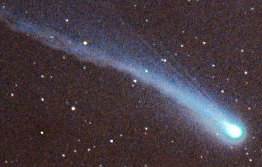153P / Ikeya-Zhang
| 153P / Ikeya-Zhang [i] | |
|---|---|

|
|
| Properties of the orbit ( animation ) | |
| Orbit type | long-period |
| Numerical eccentricity | 0.990 |
| Perihelion | 0.507 AU |
| Aphelion | 101.920 AU |
| Major semi-axis | 51.214 AU |
| Sidereal period | 366 a 186 d |
| Inclination of the orbit plane | 28.120 ° |
| Perihelion | March 18, 2002 |
| Orbital velocity in the perihelion | 58.92 km / s |
| Physical properties of the core | |
| Medium diameter | ? |
| history | |
| Explorer | Kaoru Ikeya , Zhang Daqing |
| Date of discovery | February 1, 2002 |
| Older name | C / 2002 C1, P / 1661 C1 |
| Source: Unless otherwise stated, the data comes from JPL Small-Body Database Browser . Please also note the note on comet articles . | |
The comet 153P / Ikeya-Zhang was in the year 2002 by two independently operating astronomers discovered. The Chinese astronomer Zhang Daqing discovered a new comet in the constellation Whale on February 1, 2002 , which he reported to the IAU . However, the Japanese astronomer Kaoru Ikeya discovered the comet an hour and a half earlier, as the sun sets earlier in Japan than in the People's Republic of China . But since the two observers discovered the comet independently of one another within 24 hours , the comet was given the initial designation C / 2002 C1 Ikeya-Zhang.
The comet passed its perihelion on March 18, 2002 , with an apparent magnitude of 3.5 m , so that it could be observed with the naked eye. This made it the brightest comet since C / 1995 O1 (Hale-Bopp) in 1997.
Its calculated orbital period is 366.51 years. It was later confirmed that Ikeya-Zhang had already been observed by Chinese astronomers in 1661, but is particularly identical to the comet P / 1661 C1 discovered by Johannes Hevelius on February 3, 1661 and observed until March 10. Eventually it was given the final designation 153P / Ikeya-Zhang.